It is always worth pausing to think about the moments in time that make up the lives of Eden’s residents. Here is a snapshot of early spring 2015.
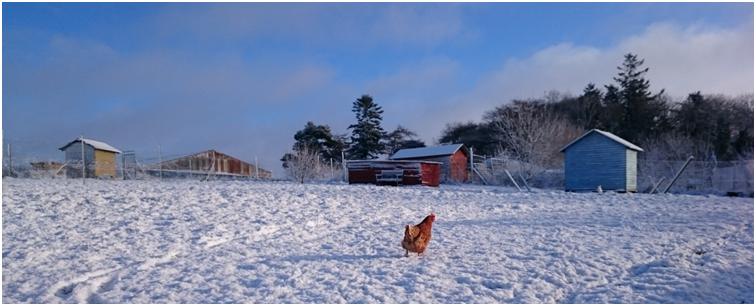
Figure 1 Claudia
It has been a long, cold winter for Eden’s residents. March dawned with a blanket of snow instead of the usual signs of growth and life that characterise spring.
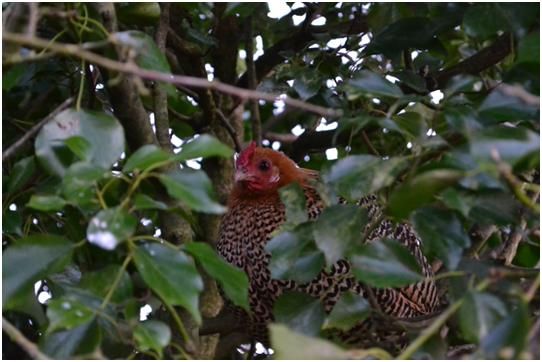
Figure 2 Genevieve in her tree (Photo courtesy of Saana Aitamaa)
Genevieve waits in her tree on cold mornings, and only flies down when we arrive to open the sanctuary. There is little point hanging around in the cold snow when the humans have not opened the breakfast feeders!
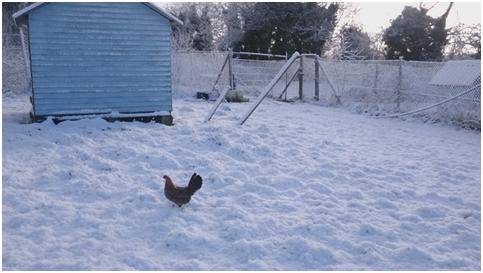
Figure 3 Genevieve heading for the breakfast feeders
Friendship
Geraldine is still in Eden’s hospital, recovering from her leg and hip injury. Her friend, Gina, refused to sleep at night until we let her into the hospital to Geraldine. Their friend Ed is very disappointed that he can’t join them. When the fence blew down in the snowstorm he managed to find a way to be with them.

Figure 4 (Left to right) Ed, Geraldine & Gina (Photo courtesy of Saana Aitamma)
However, Geraldine’s leg is still too painful to cope with Ed’s advances. He has to content himself with spending the day communicating with them through the hospital fence. Their friends are as important to them as our friends are to us.
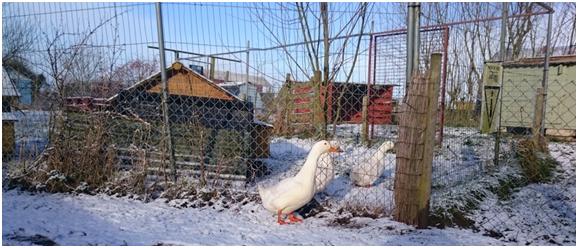
Figure 5 Ed, Geraldine & Gina
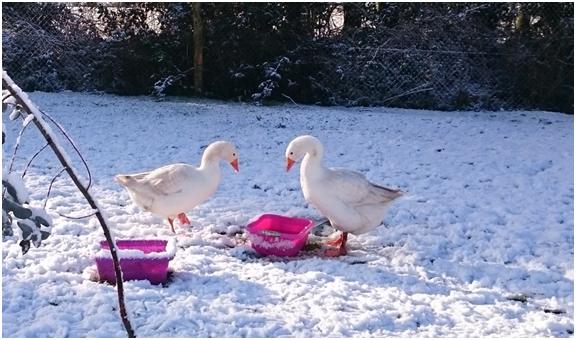
Figure 6 Adam & Paul
Adam and Paul who were rescued from slaughter at Christmas last year have settled in very well, as has Heidi who was rescued with them. Marjorie is delighted to have the company of another goose and they spend all day together.
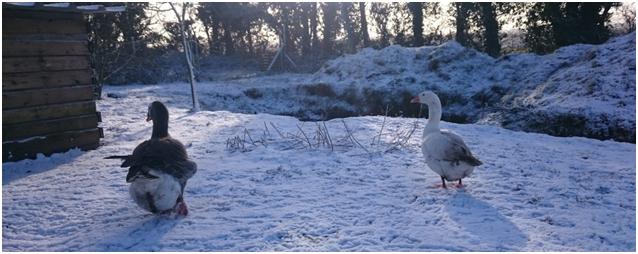
Figure 7 Marjorie & Heidi
They have started laying eggs. When this happens they begin keeping more distance from the ducks, probably in an effort to protect their eggs (which would be their future offspring if they were fertile). This must be the reason why they evicted the ducks from their house.

The ducks have now taken over the hen’s house so Sany is constructing a new house that the ducks can call their own.

Figure 8 A new house for the ducks
Animal Foods: Sick Animals
The human’s house is full of sick residents who are unable to tolerate the weather outdoors. There are so many residents living indoors that we could not even capture them all in this panoramic photo.
Figure 9 Left to right Daisy, Razzle, Helga, Alice, Margaret, Flo (Photo courtesy of Sany Strobel)

Alice is still living indoors while the weather is cold. As you can see she is in wonderful form. Her recovery from a difficult winter is testament to her tenacity to her life which is every bit as precious to her as our lives are to us.
|
|
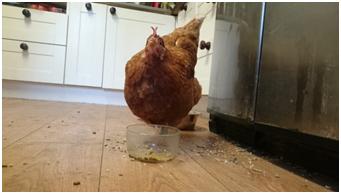 |
The same cannot be said for Flo. Flo was imprisoned in an enriched cage for the first year and a half of her life. She came to Eden via another rescue centre and has lived here since 2013. She was the last remaining member of her group of hen comrades who lived with Alex. Flo is now extremely ill and weak, her body exhausted from laying eggs for humans; yet she is obviously clinging to life. The photograph below illustrates some of the difficulties hens face when forced to lay eggs in unnatural quantities by humans. This egg is encased in the paper thin shell of an egg that was internally laid. Flo developed egg yolk peritonitis as a result.

Figure 10 Flo
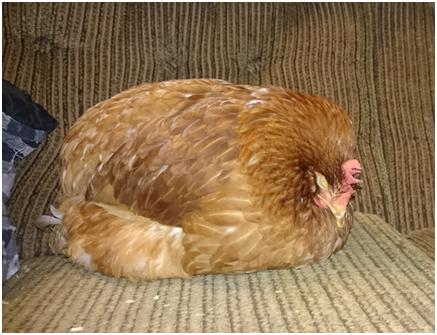
Flo appeared to recover from the worst of this infection but she is extremely weak. For the moment she is being kept pain free and warm and is able to drink a critical care formula to keep her nourished while she is unable to eat. The care she is given at Eden in no way dissolves our human ethical obligations to her. Humans are responsible for her suffering. We believe the myth that eggs are food and that they cause no harm, either to the humans who eat them or the hens who lay them. Our willingness to accept this myth facilitates our denial of the hens’ reality. If the truth of their reality was factually displayed on supermarket shelves alongside eggs, few would purchase them.
Through the lives of the residents at Eden, you can become intimately informed of the consequences for hens of human consumption of eggs.
Reproductive cancer is so prolific in egg laying hens that they are now considered a model for the study of similar cancers in human women (Johnson, KA (2009) The Standard of Perfection: Thoughts about the Laying Hen Model of Ovarian Cancer, Cancer Prev Res 2; 97). These kinds of scientific studies are completely devoid of compassion towards those used as animal models whose sentience results in suffering that is no less because they are not human; in fact, because egg laying hens are commodified they suffer and die without the benefit of medical intervention and therefore their suffering is far greater than that of human women with comparable illnesses.
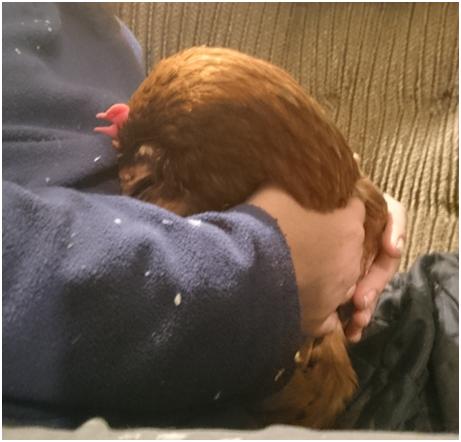
More than one third of human patients with ovarian cancer present with ascites (Ahmed, N and Stenvers, KL (2013) Getting to Know Ovarian Cancer Ascites: Opportunities for Targeted Therapy Based Translational Research, Frontiers in Oncology, 2013,: 256). A large percentage of the egg laying hens also present with this condition. Miriam is a case in point. Two weeks ago we noticed that she was not eating, drinking or moving around as normal. On examination it was obvious that she had Ascites. In the photos below we ask you to bear witness to her treatment in order to better understand the unnecessary suffering that hens are forced to endure as a result of the human demand for eggs. Please remember that Miriam was rescued from a family who kept hens in so called human conditions in their back garden. She was never caged and never debeaked. Simply being born into a body that is selectively bred for its ability to produce dark shelled eggs in unnaturally large numbers results in cancer and a shortened lifespan.

Figure 11 Intern Saana helping drain Miriam
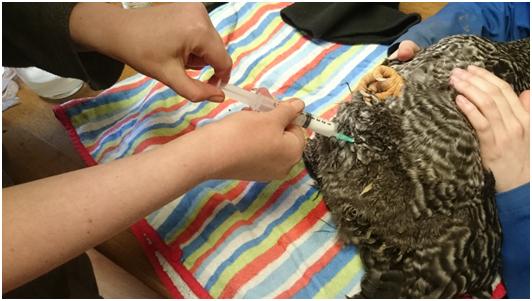
Figure 12 Draining Procedure
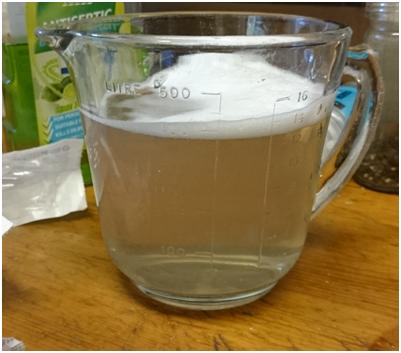
Figure 13 Fluid drained from Miriam’s body
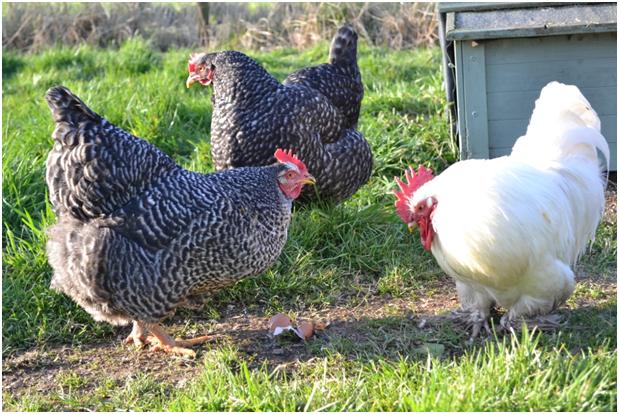
Figure 14 Miriam before her illness, enjoying an egg
We share much in common with the animals who live alongside us on earth. Like Miriam, one minute might see you enjoying life to the full, and the next see you lying in an operating theatre undergoing a traumatic medical procedure designed to provide mere palliative relief with no real promise of cure. We all dread the mere thought of it. There is no excuse to perpetrate it on others. If you still eat eggs please look at Flo and Miriam and think about the consequences of your actions; it you have any sense of justice please muster it to include all sentient beings. Going vegan means that you no longer participate in causing this kind of torture of innocent hen people who share your desire to live free of pain. You may be only one person in a world of billions of humans who create a demand for eggs, but you can stop creating a demand for any hen to lay eggs for you.
Visiting Eden
Going vegan is the most important thing you can do in your life, for yourself and for others. Nowhere is the rational for veganism as obvious as in the lived experience of the rescued animals at sanctuaries. Eden is a wonderful place to connect with these animals, learn about their personal histories, and see them in a context where their individual personalities shine, living with their friends, and freely enacting their preferences and intentions. If you, or someone you know, would like the opportunity to visit Eden please get in touch with us at edenanimalssanctuary@yahoo.ie and we will facilitate you.
Here is some of the feedback from this season’s visitors:
“The tour around Eden was great. I loved the friendliness and curiosity of all the residents, especially the little white hen called Sara who was rescued from a petting farm. No one pointed a finger at me for being a meat-eater but I was really struck when Sandra said that she was shocked when she realised that she had been causing more suffering as a (dairy & egg eating) vegetarian than when she used to eat meat. I went vegan straight away after my visit to Eden.”
Tim, 13 years old.
Figure 15 Sara rescued from a petting farm in January 2009
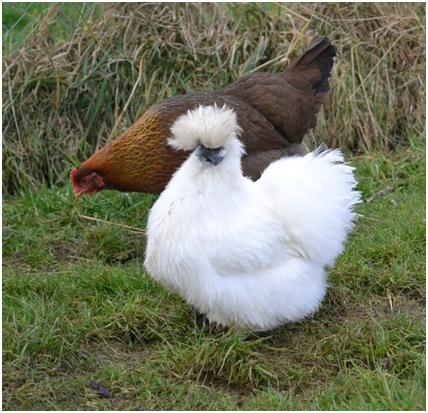
“I can’t stop thinking about Eden. I can’t get over the feeling I picked up from the residents. If I were to choose one word, I would choose “kindness”. It may sound strange but I could sense something gentle and kind all the time I was there. It so was lovely to interact with the residents, they’re so curious. So I came home pretty exhilarated! Now I hope I can start doing “something” here in Germany.”
Mary, Germany.
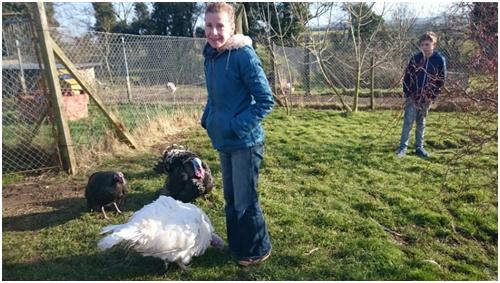
Figure 16 Mary and Tim meet the turkey people at Eden
New Residents
Spring brought shock and sadness at the end of Molly’s life. She died four weeks ago today. The memories of her are of intense and beautiful love and this is unexpectedly greater than the anticipated sorrow. She will never be forgotten for what she meant personally, and for the love she brought that unbeknownst to us instigated the opening of Eden as a home to rescued farmed animals.
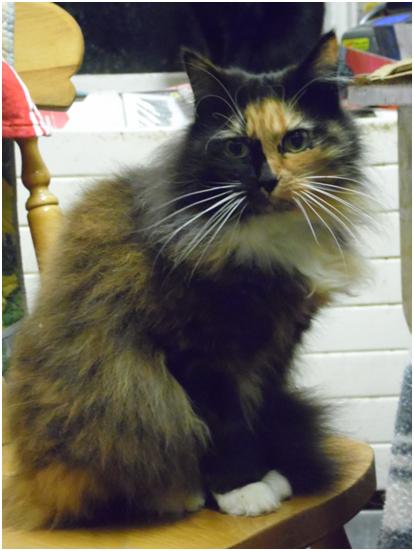
Figure 17 Lady Molly Remembered with Love
Spring has also seen the arrival of new residents. Clarissa was kept as a garden hen who provided ‘free range’ eggs. Inadequate protection left her and her friends vulnerable to predators. She witnessed two fox attacks and the deaths of all her friends from her hiding place in a tree. She must be utterly traumatised. She arrived to safety at Eden where she is now living with Alex who had been was alone since Flo (above) came to live indoors. Clarissa is named after Clara, who volunteered at Eden last year.
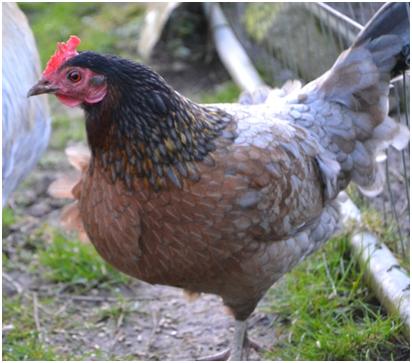
Figure 18 Clarissa

Figure 19 Alex & Clarissa
Our other new resident is a baby pigeon, approximately four weeks old when she was rescued in the shopping area of our nearest town and taken to us by our vet. X-Ray revealed soft tissue swelling and a possible wing fracture. She is now eating by herself and healing very well. We nurse wild animals with great care so that they do not become habituate to us (or to the cats). In the wild humans are not their friends. If she continues to progress we will bring her to live in the outdoor aviary for a week prior to releasing her. She might live wild and free with the other pigeons at Eden, safe from the gunshots in our neighbouring fields.

.
A New Intern at Eden
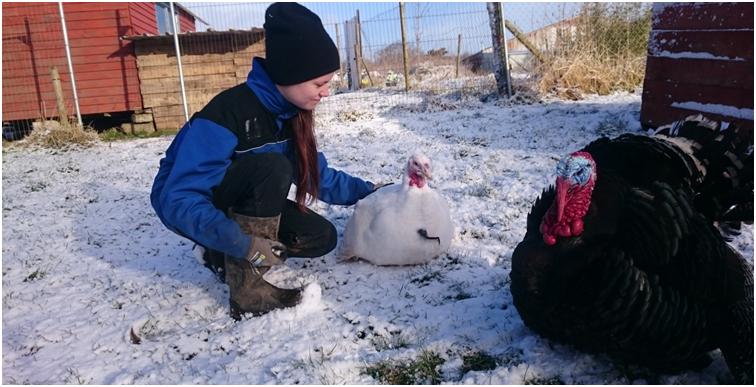
Figure 20 Sany get s hug from Saoirse
Eden has been blessed with the help of a new Intern, Saana Aitamaa. Saana is doing a course in animal care in Finland that requires several internships. It was during her first internship on a traditional farm that she went vegan, in horrified reaction to the exploitation and suffering she witnessed on a dairy and egg farm. Finding placements in non-exploitative animal care situations is very difficult. Saana’s course tutors were happy to work with Eden even though our work towards the abolition of animal use is contrary to their ethos.

Figure 21 Saana doing the daily cleaning routine (Pierre’s house)
We are delighted to have facilitated Saana and we have greatly benefited from her hard work and dedication to the residents at Eden as well as her very personable company. Her time at Eden has been characterised by a wide range of sanctuary work experience including coping with bad weather and frozen water, construction work, routine health care, and assessment, diagnosis and treatment of illness. Saana has enjoyed learning about the lives and needs of rescued animals from the best possible teachers – the residents at Eden. During these busy times good interns and volunteers are treasured at Eden. Saana is no exception and will be greatly missed when she leaves.
Figure 22 Saana carrying buckets of water to Adam & Paul approached by Claudia
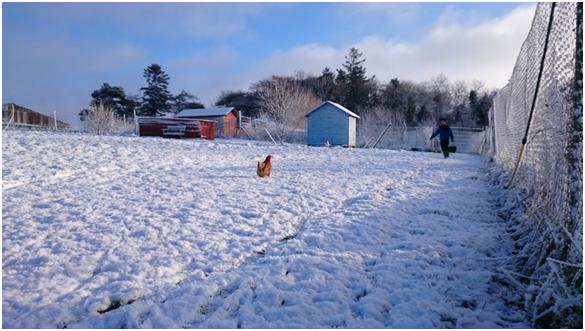
Figures 23, 19, 20: (Saana & Claudia) A good intern is never too busy for a chicken hug
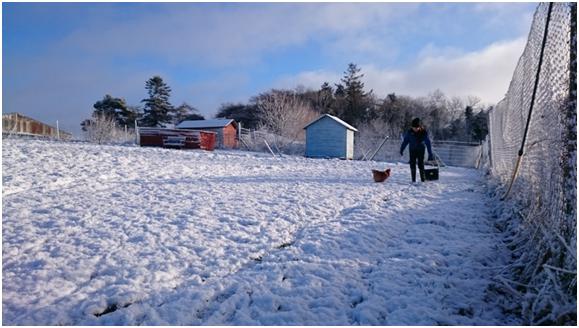
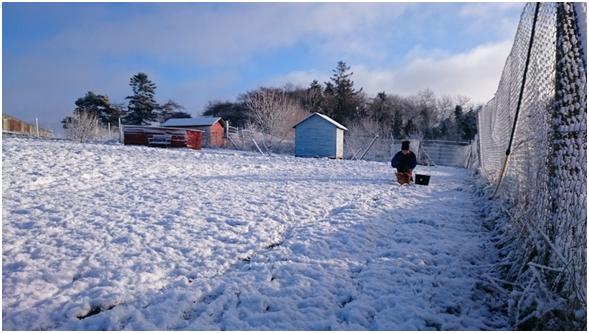
Are you vegan yet?
The lives you bear witness to in this newsletter exist because of veganism. As a vegan you can save more animals every year than a sanctuary like Eden can care for over several years. You have the power to grant individuals the right to life simply by choosing how you live your own. If you would like information, guidance and support to become vegan please contact us for free online mentoring at edenanimalsanctuary@yahoo.ie.
Raw Vegan Chocolate Caramel Slices
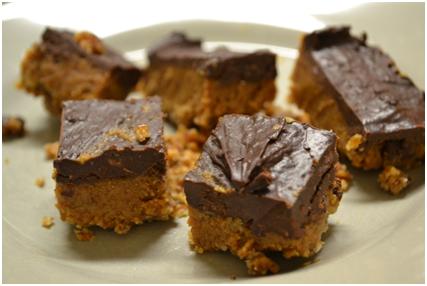
A recipe like this can be a valuable tool in vegan education, demonstrating that even decadent treats do not necessitate harming others.
Bottom layer:
1 cup of almonds
1 cup of dates
Middle layer:
1/2 cup cashew butter (peanut butter also works very well. Use a brand that does not contain palm oil)
1/3 cup coconut oil
1 cup of dates
Chocolate topping:
1/3 cup coconut oil or raw cacoa butter (the topping sets well with cacoa butter and a little softer with coconut oil)
2 tbsp raw cacao powder
1/4 cup maple or agave syrup
Method:
For the bottom and middle layer, blend each layer’s ingredient in a food processor or blender and press into a cake tin. I use a food processer for the bottom layer and a blender for the middle layer. Place in the fridge whilst you make the chocolate topping. In a small saucepan on low heat, add all the ingredients together for the chocolate topping and stir until melted. Once the chocolate topping is cool, poor over the two layers and refrigerate for 1 hour. You can cut into tiny squares because they are luscious and filling.

